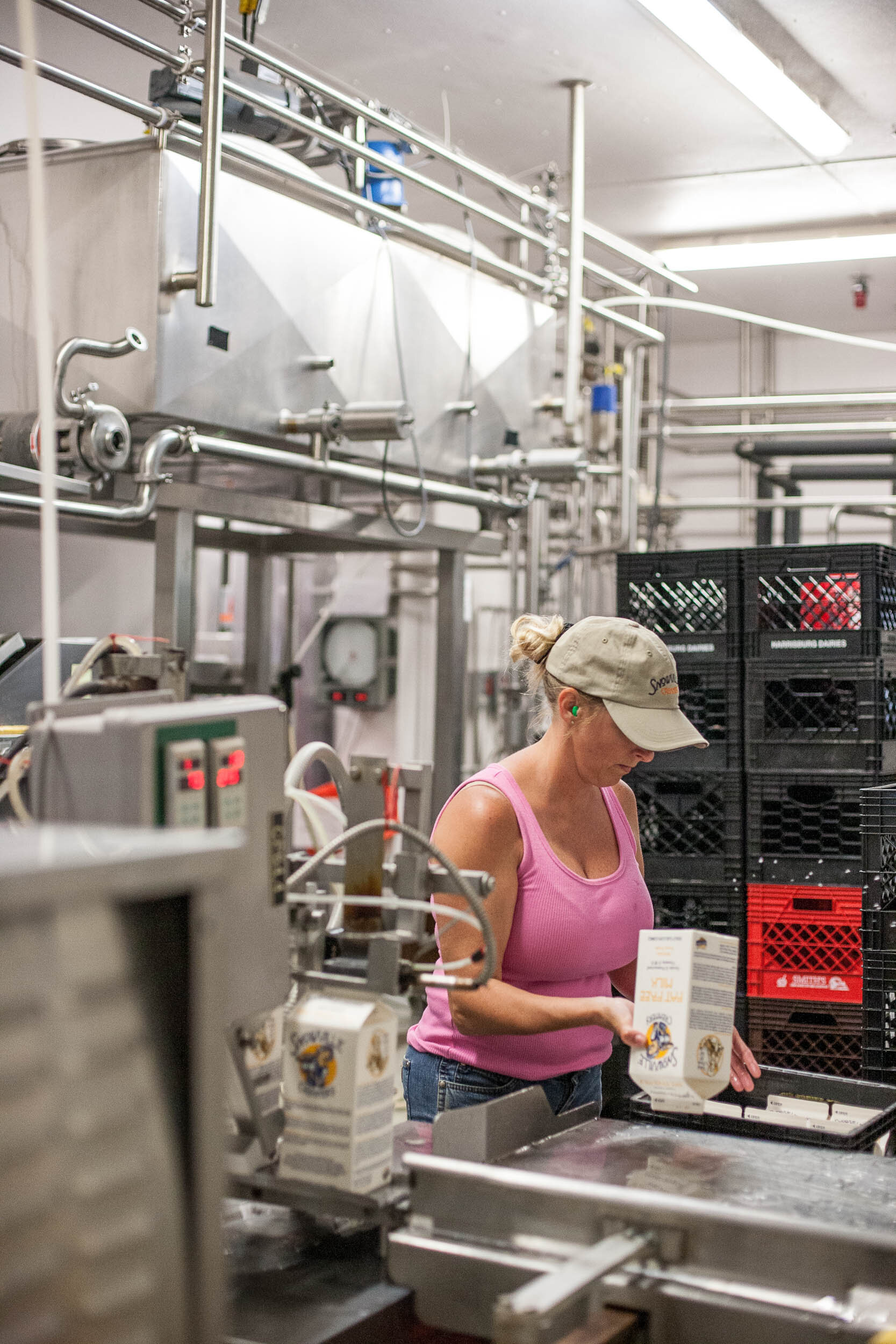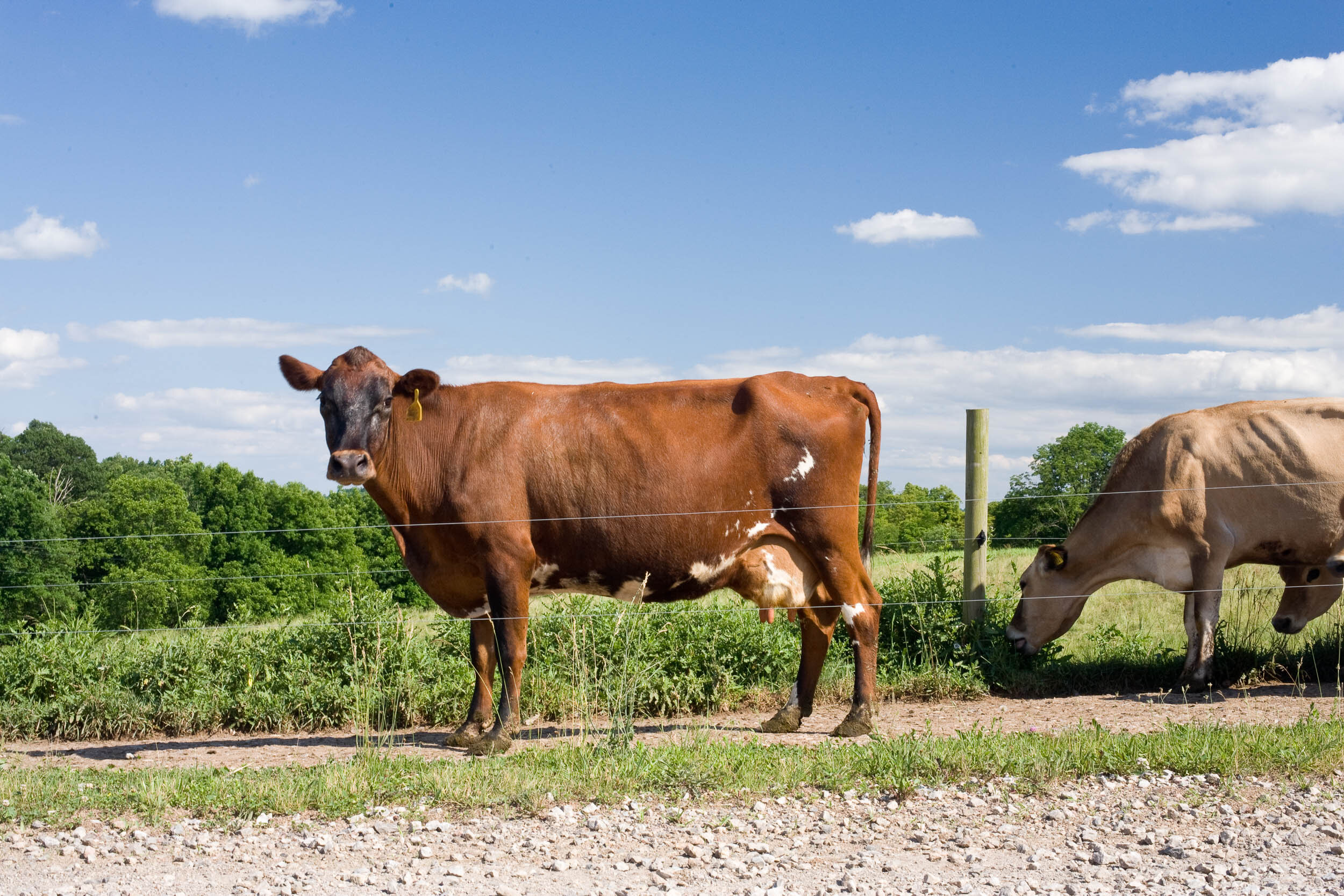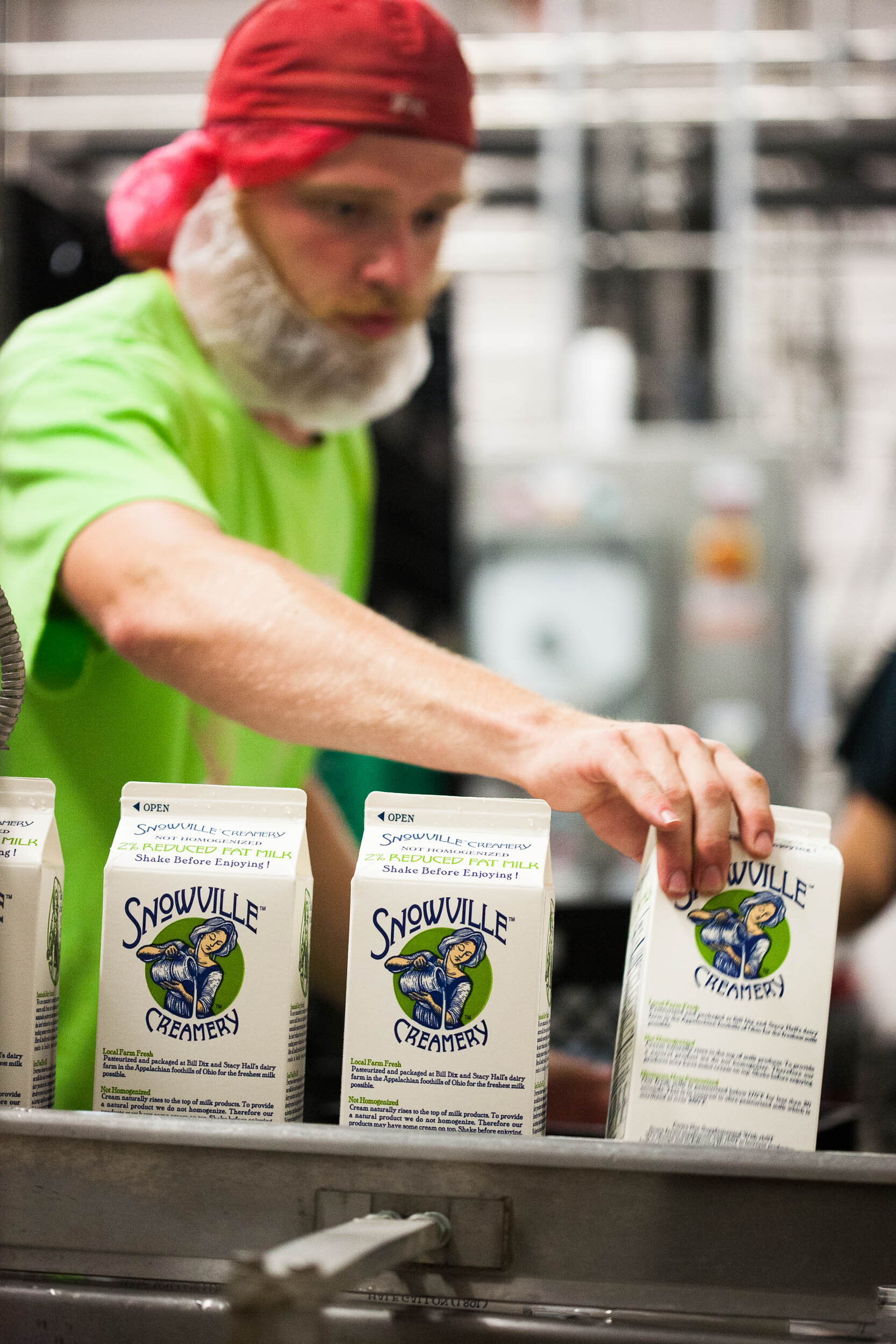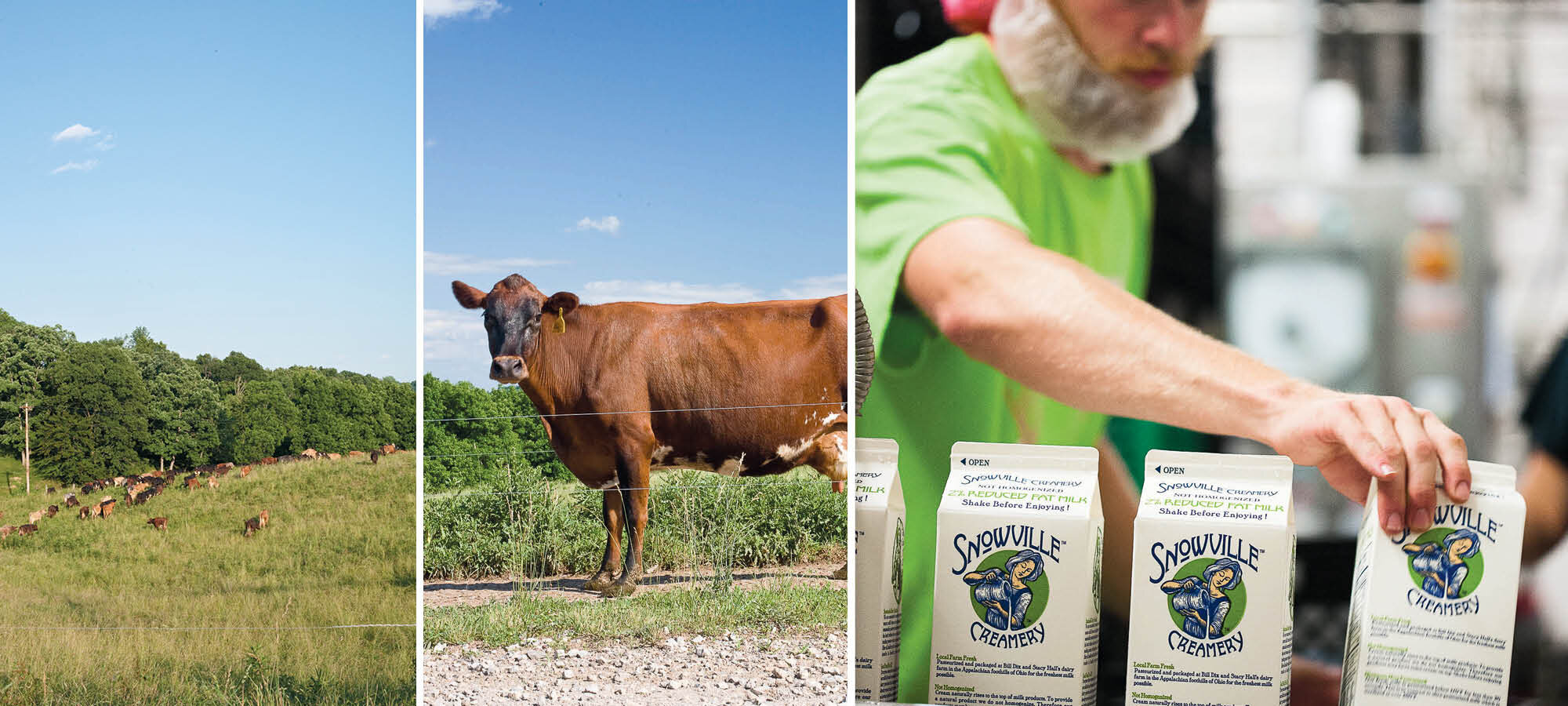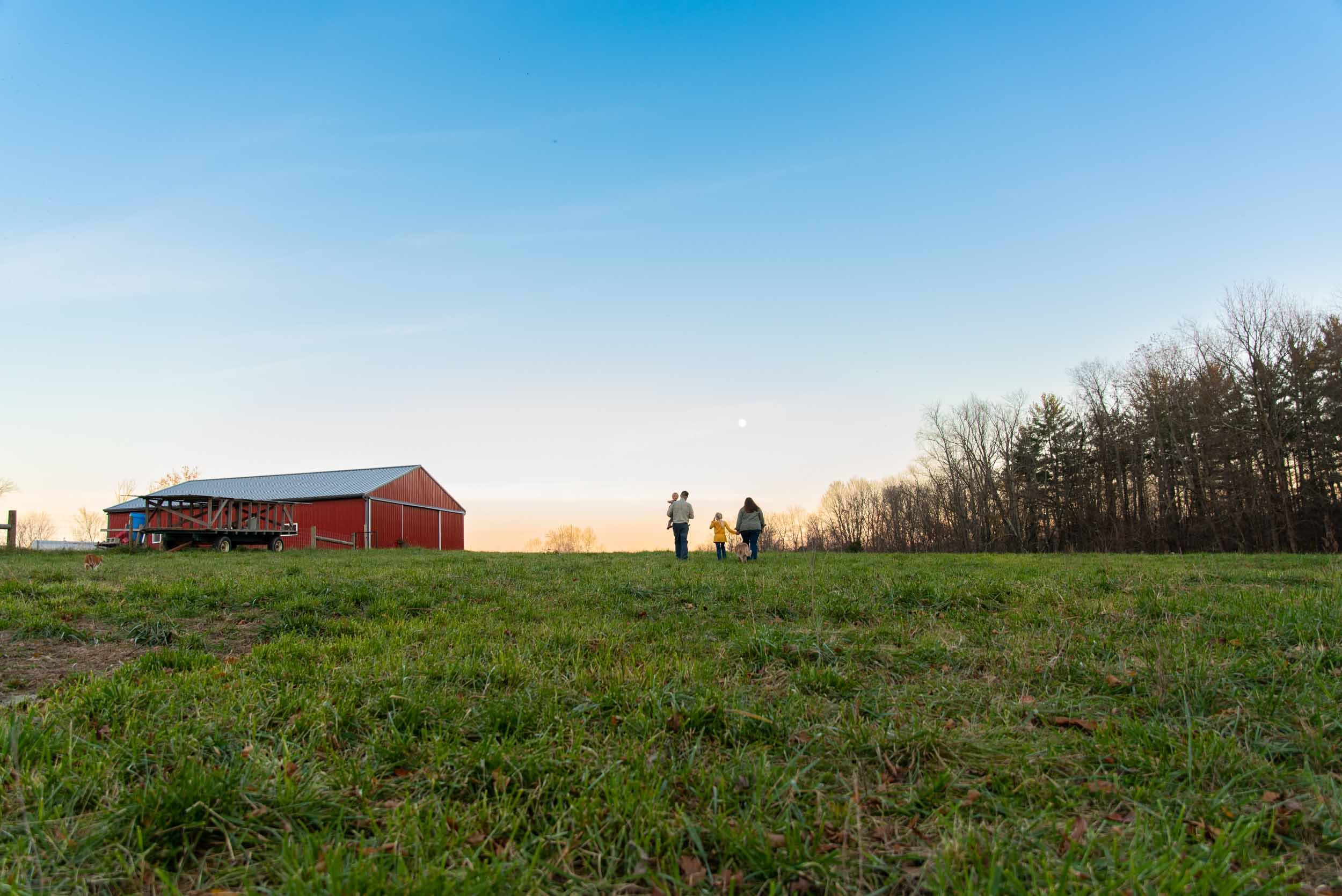The Tao of Dairy

At At 4 p.m. on the dot, 135 cows plod in single file toward the milking parlor at The Brick, Bill Dix and Stacy Hall’s 300-acre farm in Southeast Ohio’s Meigs County. The animals queue up five abreast in a holding pen that resembles a large picnic shelter. They wait patiently, snuffling softly, their big, long-lashed eyes registering nothing but calm.
A floppy-hatted farmhand, petite and tough as nails, guides the cows into the parlor, affixes the vacuum milking equipment, and speaks gently to them as they milk and munch the handful of grain they regard as a treat. Ten minutes later, they’re moving back down the fenced lane toward an open paddock. This scene will repeat at sunup tomorrow, twice a day, 365 days a year. This is the rhythm of a dairy farm.
What happens before and after the milking distinguishes The Brick from conventional dairy farms. Before: The cows graze on pasture, eating less than 10 pounds per day of grain to supplement their grass diet.
After: The milk is moved from the parlor about 200 feet to Snowville Creamery, which is owned and operated by another dedicated couple, Warren and Victoria Taylor. There, the 40 percent butterfat cream is separated from the fat-free milk, then the components are recombined in proper proportion to make half-and-half or 2%. The products are gently pasteurized at 168 degrees for 20 seconds, then chilled and packaged. Depending on the day of the week, the milk goes from cow to creamery to grocery shelf in less than 24 hours.
Snowville’s pasteurization exceeds USDA requirements but is far less hot and harsh than at conventional plants, meaning that the flavor and nutrients don’t get cooked off in the process. Further, it’s unhomogenized; the cream rises to the top, just like the milk our grandparents and their parents drank. The product is unlike the grocery-store milk we’ve become accustomed to; it’s deeply flavored, creamy in color, rich tasting, even in its fat-free form.
“Our milk varies with the seasons,” Warren Taylor says. “This time of year [in spring], the milk and cream are more yellow because the cows are eating fresh green grass. In January, it’s not as yellow and it tastes like hay. It has a range of flavors. In addition, these cows give half as much milk a day, so it’s less watery and it’s nutritionally different. It has more protein. We only give it the absolute minimum heat treatment and pasteurization. We don’t homogenize, which changes the mouthfeel.”
Taylor knows from milk. He parlayed a degree in dairy technology from Ohio State University in 1974 into a career in the dairy field, designing and engineering production facilities for some of the largest food companies in the U.S. and around the globe. In 1991, Taylor opened his own consultancy, building a tremendous reputation in the dairy field as he helped producers run efficient, safe, large-scale operations.
But it was Taylor’s deep involvement in the industry that ultimately led to disillusionment, then anger … and then to Snowville. Over his two-decade-plus career, Taylor says, the dairy business consolidated to the point where it’s now dominated by two major players: Dean Foods, a multibrand manufacturer that bottles milk and makes dairy products, and DFA, a huge co-operative of farmers. While you may buy what you think is a local or store brand of milk, chances are high that it comes from a big producer like Dean. (In fact, Dean Foods owns Newport’s Trauth Dairy and recently announced plans to cease production at the Trauth plant in Newport, Kentucky, by the end of August 2011.)
“I decided that somebody had to stand up and bring quality milk to customers,” Taylor says, pounding his fist on his drafting table, near a picture window that overlooks green pasture. “I’m trying to bring good milk back to America and to re-establish the relationship between the dairy farmer and the customer.”
Snowville Creamery does exactly that. It sits on about an acre of Dix and Hall’s property in the rolling pastured hills just outside Athens, Ohio. It’s quite literally a labor of love for both couples.
The Taylors moved from California back to Warren’s native Ohio in the mid-1990s. Seeking a decent place to raise their two young children, they opted for Meigs County, where Warren’s parents had purchased 300 acres back in the 1960s as a retreat from their home in Columbus. Warren ran his consulting practice from here and made the acquaintance of local dairy farmers Hall and Dix, from whom the Taylors purchased raw milk.
Hall and Dix had taken a major midlife risk in 1993, when both were in their mid-40s and struggling to make a livelihood raising organic vegetables and selling them in the Athens area. Faced with no savings, no retirement and a hand-to-mouth existence as vegetable farmers, they were, Hall says, “desperate” for other opportunity.
They spotted an article in the Stockman Grass Farmer magazine, which advocated the New Zealand model of grass-based livestock farming. The story said that farmers could net $1,000 per cow per year grazing their animals on grass. An $80,000 return on 80 cows looked pretty appealing to Hall and Dix. “We had to try something,” Hall says, “so we bought Jersey dairy heifers from a neighbor.”
A conversation with Hall is a lesson in agricultural economics, one that helps explain why anyone’s commitment to growing or producing healthy local food is an act of tremendous faith (and perhaps insanity) — and one that’s worthy of our support as consumers.
At The Brick, the cows are raised entirely outdoors on a diet that’s nearly all grass; the input costs for shelter, feed and waste removal are much lower than they are on a conventional dairy farm where a large herd is housed in massive barns and fed increasingly expensive grain. Grass-based farms like The Brick are essentially closed systems, where the cows manage the grassland by grazing and fertilizing it the natural way. As the grass grows, the roots grow; as it’s munched, the roots die, a process that fixes nitrogen in the soil and restores the land.
Taylor notes that Hall and Dix aren’t so much dairy farmers as they are grass farmers. “It’s the same process by which the buffalo created the six feet of rich topsoil in the Great Plains,” Taylor says. “Carbon in the soil allows it to take water in during a deluge and keep water during a drought. It fixes nitrogen in the soil — and that’s fertilizer, so you don’t have to put petrochemical fertilizer on the soil.
“You need soil that lives,” Taylor continues. “These are things that we’re just beginning to understand. This is the obvious truth: How could we ever think we could create a sustainable agriculture by pouring poison on the soil?”
Grass-based farms are far more sustainable than confined-animal farms. The flip side, economically, is that grass-based farms tend to accommodate smaller herds, and dairy cows fed grass yield less milk — less input costs but less yield. What makes the system work, Hall says, is that grass-fed cows have a longer life span than confined cows: eight to 10 years after maturity vs. two years.
“Conventional dairy expenses — housing, barn, feed, hauling away waste — all of that is expensive, and all those assets depreciate and require upkeep,” Hall says. “The conventional model is a high-volume, low-margin business. We are the opposite: a low-volume, high margin. It’s not better, it’s just different. It suits us better.”
Hall and Dix had found success as dairy farmers by the time the Taylors approached them in 2007 about building a plant on their property and packaging their cows’ milk. Like Hall and Dix back in the ’90s, the Taylors went all-in, committing their retirement, mortgaging their house, and rounding up whatever financial support they could to build the creamery.
With Warren Taylor’s vast experience designing and building dairy operations, the challenge was scaling this one down. He sourced used equipment from around the country and created a Rube-Goldbergian system in a metal-clad structure that’s remarkably small, practical, and pristine. When they ran the first production line in 2008, Warren and a plant manager operated the equipment; Victoria managed the books and a friend or two pitched in.
Warren spent the first two years almost entirely on the road, Victoria says, evangelizing for Snowville’s superior product by offering samples at farmers’ markets in Ohio and at Whole Foods stores that began carrying it. (He was the primary delivery driver, as well.)
Three years later, Snowville is growing, having doubled production in 2010 and seeking 50 percent growth in 2011. The operation employs 20 mostly young and college-educated people who manage the office and run production (including a couple of newly minted Ohio University engineering grads who help keep Taylor’s machinery humming). “They’re a very diverse group,” Victoria Taylor says of the team. “But they have to have their hearts in it. We’re too new and we operate too close to the margin to have slackers. We need ‘how can I help’ types around here.”
Because of Warren’s obsession with efficiency, the creamery is ever better to handle increased capacity. It currently produces 16,000 gallons a week in a six-day-a-week operation. Snowville’s growth comes from adding stores to its distribution and also from more shoppers choosing to put Snowville in their carts at existing stores. Still, profitability remains elusive, as additional capacity means additional equipment and essential back-up parts — all of which require what Victoria calls “sacrifice.”
Snowville’s bottom line gets a hand from a unique, symbiotic relationship with Columbus-based Jeni’s Splendid Ice Creams, whose own products are increasingly in demand and nationally recognized. Snowville produces Jeni’s ice cream base, a custom blend of cream, condensed milk (made in the plant), and sugar. It’s a long-term arrangement that guarantees a buyer for 70 percent of Snowville’s cream and generates 20 percent of the revenue.
Fat-free milk, 2%, half-and-half, a remarkable whipping cream, and a new low-fat chocolate milk are available at Remke Bigg’s, Whole Foods, Giant Eagle, and other retailers in Ohio, Kentucky, Pennsylvania, and Virginia — as well as Washington, D.C. The latter outlet is a decidedly political statement on the Taylors’ part.
For Warren Taylor, the goodness and wholesomeness of Snowville milk isn’t just about delivering a great product to the people — though that’s certainly the driving factor. But Snowville also represents his middle-finger salute to a dairy industry he sees as corrupt and unethical, run by big business and regulated by an incompetent government.
He comes by that point of view honestly and from the inside of the business. Standing at his desk, quoting from a well-thumbed through copy of Lao Tzu’s Tao Teh Ching and the writings of Ralph Nader, Taylor describes a system that has increasingly separated consumers from farmers. “The dairy industry is populated by middlemen who are making unconscionable profits without taking any risk or adding any quality or value,” he says. “They’re absolute bums.”
Large confined-animal operations have the capital and acreage to operate their own processing plants, but small family farms have to sell their cows’ milk to consolidators, who buy from a bunch of farmers, comingle all the milk and then sell it to the likes of manufacturers like Dean Foods, which bottles it or converts it to butter, cheese, or sour cream. The result, Taylor says, is poorer-quality product for consumers, stingy margins for farmers, and fat wallets for the food giants and their middlemen.
“We have a completely counterproductive USDA/dairy lobby in Washington, D.C., that’s clearly succeeding in concentrating wealth and power in the hands of a very few people who have control over the production of milk and the purchase from farmers,” he says, pointing to what he calls a too-cozy relationship between big manufacturers and the big farm co-op. He still travels to Washington for industry group meetings, toting along cartons of Snowville and carrying the banner for healthy, honest foods.
Taylor is a modern-day Johnny Appleseed bringing good food to the people, along with the religion of local produce and sustainable farming. But being simply a local provider isn’t the end game. “Being local isn’t good enough,” he says. “It has to be good.”
Snowville is good, and customers and retailers are noticing. The creamery’s fortunes are linked with two other small, regional businesses that are also growing rapidly: the aforementioned Jeni’s in Columbus as well as Tiny Footprint Distribution, the parent company of Green Bean Delivery, which brings Snowville to grocery stores in Cincinnati. This summer, Tiny Footprint expanded into the Dayton, Ohio, and Louisville, Kentucky, markets, opening up new retail accounts. Still, gaining access to the capital it takes to add equipment, increase production, and meet growing demand remains the Taylors’ biggest obstacle.
Taylor estimates that there are fewer than 100 operations like Snowville in the U.S., and he’ll preach to any listener about his vision for more and more local dairies producing high quality milk at good prices. But Taylor isn’t all about milk; he’s teaming with other local food growers and providers to create a “food hub” based in Columbus, where small producers can collectively distribute their goods to retailers and restaurants.
This idea of community — not just among farmers but between small food producers and customers — gives deeper meaning to what Hall, Dix, and the Taylors have staked their livelihoods on. We consumers play an important role in this community, not just by buying local products but also by evangelizing about local producers. Love the cheese you buy at your neighborhood farmers’ market? Don’t just spend your money; tell your friends. You can support these producers by helping to create a bigger market for their goods.
“This is a political/social justice stand,” Taylor says. “We’re being an example of community-based capitalism for the purpose of meeting a common public need in a way that serves the community.”

